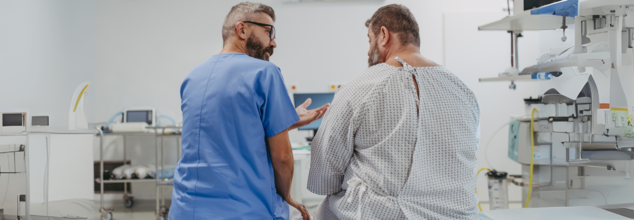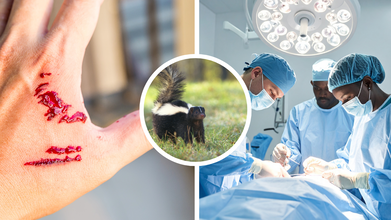- Health Conditions A-Z
- Health & Wellness
- Nutrition
- Fitness
- Health News
- Ayurveda
- Videos
- Medicine A-Z
- Parenting
Cancer Related Deaths Linked To Obesity Have Tripled In US - What Are The Reasons Behind This Spike?

(Credit-Canva)
Obesity has been a growing concern worldwide, while more people are aware of how being obese affects their health, obesity continues to be a problem, with the statistics showing concerning numbers. The National Institute of Diabetes and Digestive and Kidney Diseases 2017-18 data revealed that one out of three adults are overweight, two out of five adults have obesity, and one in 11 adults are suffering from severe obesity. However, it doesn’t end there. A new study has revealed how this concerning pattern has also raised the numbers of death associated with obesity.
A new study presented by the Endocrine Society reveals a concerning trend: deaths from cancers tied to obesity have more than tripled in the U.S. over the last two decades. Between 1999 and 2020, the number of deaths from 13 types of obesity-related cancers jumped from 3.7 to 13.5 deaths per million people.
Rising Impact of Obesity on Cancer
This research highlights how important it is to have focused public health plans, like earlier cancer screenings and better access to healthcare, especially in areas where people are at high risk, like rural or underserved communities.
Currently, over 40% of adults in the U.S. are obese, and cancers linked to obesity make up 40% of all cancer diagnoses each year. These cancers include those affecting the esophagus, breast, colon, uterus, gallbladder, stomach, kidney, liver, ovaries, pancreas, thyroid, and brain, as well as a blood cancer called multiple myeloma.
For this study, researchers looked at data from the U.S. Centers for Disease Control and Prevention (CDC), tracking over 33,500 deaths from cancers connected to obesity.
Overall, deaths from obesity-related cancers increased by almost 6% each year on average between 1999 and 2000. However, the period between 2018 and 2020 saw a sharp rise, with the death rate climbing by more than 19% annually.
Who's Most Affected By This Spike In Cases?
The study also showed significant increases in obesity-related cancer deaths among certain groups. These included women, older adults, Black individuals, Native Americans, and people living in rural areas.
Geographically, the Midwest had the highest rate of these cancer deaths, with nearly 8 deaths per million, while the Northeast had the lowest, at under 6 per million. Looking at individual states, Vermont, Minnesota, and Oklahoma had the highest rates, while Utah, Alabama, and Virginia had the lowest. Given these alarming trends, researchers concluded that it's crucial to have specific public health efforts. These should include prevention strategies, early screening programs, and making sure everyone has fair access to healthcare.
What Has Influenced This Influx?
According to the Obesity Medicine Association (OMA), the rise in obesity rates could be traced back to 1976 and 1980. The problem grew at roughly the same time for men and women, people of all ages, and all racial and ethnic groups. The number of people who were obese kept steadily going up until at least 2016.
The cause seems very closely tied to big shifts in what Americans started eating. It’s not so much about changes in how much fat or carbohydrates people were consuming.
The OMA suggests that the strongest link to the obesity problem is ultra-processed foods (UPFs). Think of these as foods that are heavily changed from their natural state. They're often packed with lots of calories, salt, sugar, and unhealthy fats, but have very few natural, whole ingredients.
Role Of Sugary Food and Surge In Calorie Intake
According to a 2022 study published in the Nutrient journal, a major part of why the obesity rate increased came down to simply eating more calories. On average, Americans now eat 23% more calories each day than they did in 1970. A significant portion of these daily calories—almost half—come from flour and grain products.
The study noted that a report from 2016 looked at what Americans were eating. It found that people were consuming more sweeteners made from corn and more cheese than two decades prior. Interestingly, they were eating less beef and drinking less milk. It's tough to point to just one food trend as the sole cause of rising obesity.
Americans are also cooking at home less and eating out more, which can make it harder to control portion sizes and make healthy food choices. Plus, for some people, limited income means healthier foods are simply too expensive. Other possible reasons for the increase include spending more time in desk jobs and walking less.
Other Reasons Attributed to Weight Gain
The study also explained how in the recent years, rates of depression and anxiety have climbed. Mental health and weight have a complex connection. These conditions can lead people to eat emotionally or feel less motivated to make healthy changes in their lives.
It’s likely that a combination of all these factors has led to the rise in obesity rates. It's important to remember that everyone is different, with their own experiences, lifestyle, and health background.
How Can We Avert This Health Crisis?
According to the OMA, applying the four pillars of obesity treatment could be the answer to this crisis which are nutrition therapy, physical activity, behavioral modification, and medical interventions.
Nutrition Therapy
A balanced diet, full of whole foods like fruits and veggies, along with low-fat dairy and various proteins, is key to preventing and treating obesity effectively. Encourage cutting back on processed items and limiting sugar to less than six teaspoons daily. Drinking more water also helps.
Physical Activity
Increasing physical activity and getting enough sleep are essential for maintaining a healthy weight. Aim for about 2.5 to 5 hours of moderate exercise weekly. Even small steps, like a gradual increase in daily walking, can make a big difference.
Behavioral Modification
Adjusting daily habits can be tough for those struggling with obesity. Behavior modification helps tackle challenges like unhealthy eating and inactivity. This might include personalized plans or therapy to address food triggers and promote lasting positive changes.
Medical Interventions
For some, medications or surgery can also help manage obesity. Medicines often work by reducing appetite or making you feel full. Surgery can alter the stomach or digestive system for significant weight loss, usually for severe obesity.
Fact Check: Does Japan Have A Fat Law?

Credits: Canva
The internet is obsessing with the idea that Japan has a fat law, it fines people for being "fat". Talk about sensational headlines, mistranslations, and social media exaggerations. But what does Japan's so-called 'fat law' actually say? Does it really change anything?
Health and Me did a closer fact check on Japan's Fat Law, and here is what we found.
Japan's Metabo Law: What It Really Means?
In 2008, the Japanese Ministry of Health, Labour and Welfare introduced the Metabolic Syndrome Countermeasures Promotion Law, which was popularly nicknamed the 'Metabo Law'. the word 'metabo' comes from metabolic syndrome, a cluster of high-risk conditions that include elevated blood pressure, high blood sugar, abnormal cholesterol, and excess fat around the waist. If left untreated, this could increase the risk of heart attacks, stroke and diabetes.
The law's main focus is on identifying these risks as early as possible. As part of Japan's long-standing annual health check tradition, about 50 to 56 million adults aged 40 to 74 undergo this mandatory waist measurements every year. The waistline thresholds are:
- 85cm for men
- 90cm for women
While the numbers are not arbitrary, they match the International Diabetes Federation's guidelines used to screen metabolic risks.
Is It Illegal To Be Overweight In Japan?
The Times-Union fact check confirms: "Japanese citizens cannot be fined or imprisoned for being overweight". RosePlus Japan also reports that the term "fat tax is a mistranslation and that "it is not illegal to be fat in Japan".
The law does not:
- Fine individuals for their weight
- Send people to jail for being overweight
- Deport or deny visas based on size
- Ban obese people
How Does The Law Actually Work?
The law basically shifts the responsibility away from individuals to governments and employers.
Annual measurement: Employers and local authorities measure the waistlines of eligible adults.
If someone exceeds the limit:
- They are offered counseling, health guidance, and follow-ups.
- After three months, progress is reviewed.
- After six months, they may receive additional health education.
No individual penalties: There is no fine for not losing weight.
Employer penalties:
- If a company fails to reduce the percentage of employees at risk, it may face increased contributions to national healthcare funds.
- Companies like NEC previously estimated potential fines of up to $19 million for not meeting targets
This structure makes the Metabo Law more of a workplace wellness mandate than a personal weight regulation.
Lost In Translation
Much of the misunderstanding comes from how Japanese concepts were translated in English. With the word "law" being reported internationally, it implied a strict legal prohibition.
"Metabo" was incorrectly equated was being "fat", losing its medical meaning.
Was The Law Successful?
- Japan already had one of the lowest obesity rates in the world, around 3.5 percent in 2009, compared to over 30 percent in many Western countries.
- Life expectancy in Japan has remained among the highest globally.
- However, obesity rates among men (based on BMI 25+) reportedly continued rising, reaching 31.7 percent in 2022 according to The Japan Times, as cited in the HR Digest analysis
However, there have been things that changed since 2008. This includes companies offering nutrition workshops, physical activity support, health check programs for employees and their families. The annual health checks are now more structured. People flagged for metabolic syndrome were connected with counselling and monitoring, which can reduce long-term medical costs. The conversation has now also shifted towards body autonomy, public health and role of employers in personal wellness.
Diagnostic Anomaly: In An 'Exceptionally Rare' Case, Man Dies Of Rabies After Kidney Transplant

Credits: Canva
In a what doctors call an "exceptionally rare event', a Michigan man has died of rabies after receiving a kidney from a donor who was unknowingly infected with the virus. A recent report from the Centers for Disease Control and Prevention (CDC) gives information on how this rare medical event took place, with a surprising chain of exposures that vegan with a skunk scratch.
A Routine Kidney Transplant That Took a Sudden Turn
The Michigan patient underwent a kidney transplant at an Ohio hospital in December 2024. For several weeks, he seemed to be recovering normally. About five weeks after the procedure, he suddenly developed worrying symptoms such as tremors, weakness in his lower limbs, confusion and urinary incontinence. His condition deteriorated quickly and he was admitted to the hospital, soon requiring ventilation. Despite treatment, he passed away. Postmortem tests confirmed that he had rabies, a diagnosis that shocked doctors since his family said he had not been around any animals.
The Donor’s Skunk Encounter Comes to Light
The unexpected diagnosis pushed doctors to take another look at the kidney donor, a man from Idaho. In the Donor Risk Assessment Interview, he had mentioned that a skunk had scratched him. At the time, this detail did not raise major concern. When investigators spoke to the donor’s family again, they learned more about the incident. A couple of months before his death, the donor had been holding a kitten in a shed on his rural property when a skunk approached and behaved aggressively. He stepped in to protect the kitten and managed to knock the skunk unconscious. Before that happened, the animal scratched his shin deeply enough to draw blood. He believed he had not been bitten, and the incident was never viewed as a medical emergency.
The Donor’s Rapid Decline
Around five weeks after the skunk encounter, the donor began showing symptoms that closely resemble rabies. He became confused and had trouble swallowing and walking. His family said he experienced hallucinations and complained of a stiff neck. Two days later, he was found unresponsive at home after what was believed to be a cardiac arrest. He was resuscitated and hospitalized but never regained consciousness. He was declared brain dead after several days, and his organs, including his left kidney, were donated.
What Investigators Found
Once rabies was detected in the kidney recipient, authorities examined stored laboratory samples from the donor. These tests were initially negative. However, kidney biopsy samples revealed a strain that matched silver-haired bat rabies. This finding suggested that the donor had in fact died of rabies and unknowingly passed the virus to the transplant recipient.
Investigators believe a likely three step transmission occurred. A bat infected a skunk, the skunk infected the donor, and the donor’s kidney infected the recipient. The CDC noted that only three other cases of rabies transmission through organ transplantation have been reported in the United States since 1978.
Steps Taken to Protect Other Recipients
Three other people had received cornea grafts from the same donor. Once the risk was identified, the grafts were removed and all three individuals received Post Exposure Prophylaxis. They remained healthy and showed no symptoms.
A Reminder of Rare but Real Risks
Rabies is not routinely tested for in organ donors because human cases are extremely rare and difficult to diagnose. In this situation, the donor’s earlier symptoms were attributed to existing health conditions. Speaking to the New York Times, Dr Lara Danziger-Isakov said the case was exceptionally rare and reminded the public that the overall risk to transplant recipients remains very small.
China Reversed Its Air Pollution Problems; What Lessons Can Delhi Learn?

Credits: Canva
Delhi continues to wake up to thick haze on Wednesday morning, with 28 stations in 'poor' category, while nine stations remained under 'very poor'. Though there is a slight improvement as the average AQI stood at 269, in poor category. The Chief Minister of Delhi has enforced stricter measures like imposing fines up to Rs. 5,000 for open burning, and use of coal and firewood.
Delhi pollution has now affected people way beyond their respiratory health, it has now attacked almost all organs of their body, including fetus, reproductive health, liver, kidneys, and even chronic diseases like diabetes, obesity, blood pressure, and even mental health illness.
But could Delhi do more? Right now all the measures, including emergency measures like GRAP have not worked more than a dent. However, China seems to have reverse its pollution problem.
What Did China Do That Delhi Too Can Adopt?
In 2013, Beijing was battling with pollution problem. As per the data by the World Health Organization (WHO), in 2013, the annual means of PM2.5 levels reached 64.9 micrograms per cubic meter, whereas, in India, it was at 58.2. However, by 2019, China was able to bring it down to 38.15 micrograms per cubic meter while India remained at 50.17.
So, what did China do?
Since 2013, almost 80% of China has experienced air quality improvement. Beijing declared a war on pollution by shutting 3,000 coal boilers, which slashed coal use by 30%. It also forced factory to either close or comply with the guidelines. Clean energy also replaced soot and electric buses replaced diesel ones. The subway was expanded to 1,000 kilometers and by 2020, 40% of new cars were electric.
Chin's 11th Five Year Plan That Made Pollution A Priority
In the late 2000s, China began taking air pollution more seriously than ever. As per the UCLA Law professor Alex L Wang, China's 11th FYP (2006-10) made pollution a priority and used the "cadre evaluation system". This pushed officials to meet environmental targets. The system evaluates governors, mayors, and local leaders based on how well they perform compared to others in tackling pollution problem, which influences their promotions.
To cut pollution, China invested heavily in cleaner technology and shut down old, highly polluting factories such as power plants, smelters, and chemical units. The government also encouraged the shift to electric vehicles. Even though much of China’s electricity comes from coal, EVs still produce fewer emissions overall and create no tailpipe pollution in cities.
By 2017, Shenzhen became the first city in the world to fully electrify its 16,000 buses. Shanghai too followed its lead.
Studies by Tsinghua University and the Beijing Environmental Bureau showed that between 2013 and 2017, major improvements in air quality came from reducing coal boiler use, cleaner home heating, shutting down polluting industries, and controlling vehicle emissions.
The result was nothing less than remarkable. From 2013 to 2017, Beijing’s PM2.5 levels dropped by 35%, and life expectancy rose by 4.6 years.
© 2024 Bennett, Coleman & Company Limited

